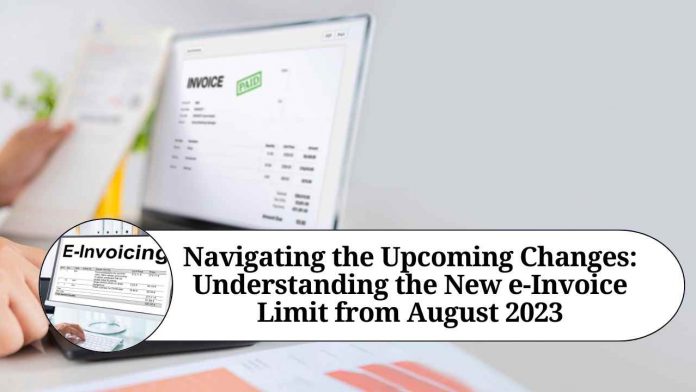Introduction:
In a digital age where automation and electronic transactions have become the norm, governments around the world are actively embracing electronic invoicing (e-invoicing) as a means to simplify business processes, reduce paperwork, and enhance tax compliance. As part of this ongoing global digital transformation, several countries have implemented or are planning to implement e-invoice limits to ensure widespread adoption. In this blog post, we will delve into the upcoming changes in the e-invoice limit set to take effect from August 2023.
Understanding e-Invoicing:
Electronic invoicing, or e-invoicing, refers to the process of generating, transmitting, and storing invoices electronically, replacing traditional paper-based invoices. It involves the direct exchange of structured invoice data between the supplier and the buyer’s financial systems, eliminating manual data entry and reducing the risk of errors.
E-invoice Limit: Why is it Important?
The e-invoice limit is the monetary threshold beyond which businesses are required to generate and transmit their invoices electronically, instead of using traditional paper-based methods. This limit is typically set by the government or tax authorities to promote the adoption of e-invoicing and facilitate better tax compliance.
Changes in the e-Invoice Limit from August 2023:
Starting from August 2023, several countries are set to introduce or revise their e-invoice limits, further encouraging businesses to embrace electronic invoicing. While the specific changes may vary by country, the overall objective remains consistent: to drive digitalization and streamline tax processes.
Increased Threshold:
In many cases, the new e-invoice limits are expected to be significantly higher than the previous thresholds. This adjustment allows smaller businesses to continue using traditional invoicing methods until they reach the revised limit, providing them with more time to adapt to electronic invoicing systems.
For instance, a country that previously set its e-invoice limit at $10,000 may increase it to $50,000 or higher. This change ensures that businesses with lower invoice volumes can focus on their core operations without immediate pressure to adopt e-invoicing.
Mandatory Compliance:
With the revised e-invoice limits, businesses that exceed the threshold will be required to implement e-invoicing systems and transmit their invoices electronically. This move aims to reduce tax evasion, enhance tax reporting accuracy, and facilitate the seamless flow of information between businesses and tax authorities.
Benefits of the New e-Invoice Limit:
- Enhanced Efficiency: The higher e-invoice limits allow businesses to utilize traditional invoicing methods until they reach the revised threshold. This enables them to streamline their operations without the immediate need for digital transformation, thus maintaining efficiency in their current processes.
- Improved Tax Compliance: Implementing e-invoicing systems ensures accurate reporting of financial transactions, minimizing errors and potential discrepancies. By aligning with the new e-invoice limit, businesses can comply with tax regulations more effectively, reducing the risk of penalties and audits.
- Cost Reduction: Shifting from paper-based invoices to electronic formats reduces costs associated with printing, storage, and manual processing. With e-invoicing, businesses can also eliminate errors caused by manual data entry, saving time and resources.
- Environmental Sustainability: The widespread adoption of e-invoicing reduces paper consumption and the carbon footprint associated with traditional invoicing methods. By minimizing waste and promoting sustainability, businesses can contribute to a greener future.
Conclusion:
From August 2023, the changes in e-invoice limits across various countries mark another significant milestone in the global digitalization of invoicing processes. Businesses should stay informed about the specific regulations in their respective regions and prepare for the transition to e-invoicing systems to ensure compliance and enjoy the benefits of streamlined operations, improved tax compliance, cost reduction, and environmental sustainability. Embracing e-invoicing not only simplifies business transactions but also contributes to the broader vision of a digital and sustainable economy.
Read more useful content:
Frequently Asked Questions (FAQs)
Q.What is an e-invoice limit?
An e-invoice limit refers to the monetary threshold set by the government or tax authorities, beyond which businesses are required to generate and transmit their invoices electronically instead of using traditional paper-based methods.
Q.Why do countries set e-invoice limits?
E-invoice limits are set to promote the adoption of electronic invoicing, streamline tax processes, enhance tax compliance, reduce paperwork, and facilitate the exchange of structured invoice data between businesses and tax authorities.
Q.When will the new e-invoice limits take effect?
The new e-invoice limits are set to take effect from August 2023 in many countries.
Q.Will the new e-invoice limits be higher or lower than before?
Generally, the new e-invoice limits are expected to be higher than previous thresholds. This allows businesses with lower invoice volumes to continue using traditional invoicing methods until they reach the revised limit.
Q.What happens if my business exceeds the e-invoice limit?
If your business exceeds the e-invoice limit, you will be required to implement e-invoicing systems and transmit your invoices electronically to ensure compliance with tax regulations.
Q.What are the benefits of the new e-invoice limits?
The benefits of the new e-invoice limits include enhanced efficiency, improved tax compliance, cost reduction, and environmental sustainability. Businesses have more time to adapt to e-invoicing systems, leading to streamlined operations and reduced paperwork.
Q.Do all countries have the same e-invoice limits?
No, e-invoice limits vary by country. Each country determines its own threshold based on its tax regulations and digital transformation strategies.
Q.How can businesses prepare for the new e-invoice limits?
Businesses can prepare for the new e-invoice limits by understanding the specific regulations in their respective countries, exploring e-invoicing solutions, and implementing systems that facilitate electronic invoice generation and transmission.
Q.Are there penalties for non-compliance with the e-invoice limits?
Non-compliance with e-invoice limits can result in penalties, fines, or audits from tax authorities. It is essential for businesses to ensure compliance to avoid any legal or financial repercussions.
Q.Will the new e-invoice limits impact smaller businesses?
The revised e-invoice limits often take into consideration the size and volume of smaller businesses. The higher thresholds give them more time to adapt to e-invoicing systems, minimizing the immediate pressure to implement electronic invoicing methods.




















